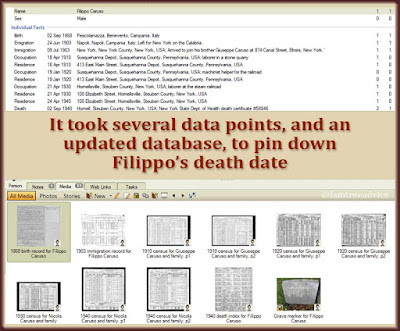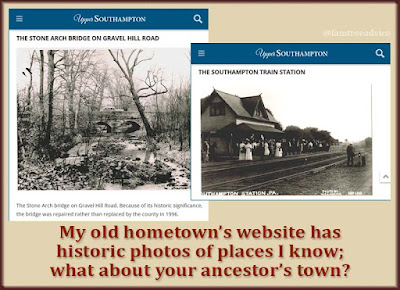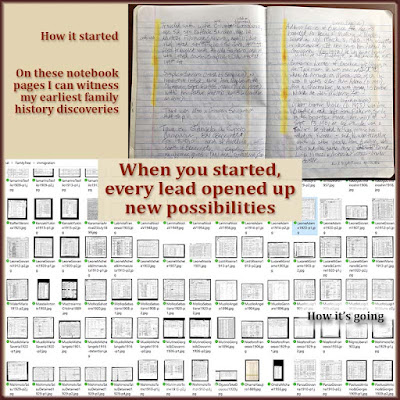When I'm adding people and facts to my family tree, I can feel my mind racing. I'm running through a decision tree to decide the next step.
What's a decision tree? It's a series of questions where each answer tells you which way to turn. I follow this type of path without realizing it. Let's take a look at this process and see how you can best apply it to your family tree research.
Fix an Illogical Birth Year
There's a man named Donato in my family tree with an estimated birth year of 1715. He had two children with an estimated birth year of 1790. Making babies at age 75 is definitely pushing it, even though Charlie Chaplin did so at age 73.
How would you figure out whether his age estimate is a mistake? Here's my thought process:
- In my family tree, Donato has an exact date of death in 1792. Let's take another look at that death record to see if it states his age.
- I have several versions of the death record, and each one says he was 57 years old.
- That would mean Donato was born in 1735, not 1715.
Does that work? Let's keep going through the logic.
- I have two wives for Donato. Is it possible that I combined two different men with the same name? Let's check each copy of his death record.
- No, I did not combine two men. One copy of his death record mentions both his wives by name.
- Donato's estimated birth year matches that of his first wife Anna, but where did it come from? Let's look at their family.
- My family tree has two children for Donato and Anna. It says they were born in 1740 and 1765. The 1715 estimate is 25 years earlier than their first child Teresa's 1740 birth year. That's my usual formula—25 years before the first child's birth is the estimated birth year.
- Is 1740 the correct birth year? Let's look more closely at Teresa.
- Teresa's husband was born in 1759 and they had a son in 1793. It's ridiculous to think she had a baby at age 53 with a man 19 years her junior.
- Where did I get her 1740 birth year? I have an 1800 death date for Teresa, so let's look at the death record.
- Aha! Teresa died in 1825, not 1800. I've never seen such a blatant error in my tree! Her 1825 death record says she was 65 years old.
- Now I know Teresa was born in 1760, not 1740. That means her parents' birth year estimate should be about 1735 (1760-25).
Donato's death record is logical after all. It says he was born in 1735, and that what the logic says, too. Problem solved!
 |
| When the data in your family tree makes no sense, get more data! |
Narrow Down a Missing Death Date
Not all death records are easily available to us. When that happens, you can use logic to narrow down the death to a range of years. Here's the example of my 2nd great uncle Filippo Caruso.
- I have Filippo's 1868 birth record from their hometown in Italy.
- This helped me find him coming to America in 1903 to join another brother, Giuseppe, in Elmira, New York.
- I found him living with Giuseppe in both the 1910 and 1920 censuses in northern Pennsylvania. I needed to keep following Filippo through time.
- In the 1930 and 1940 censuses he is living with another brother, Nicola, in Hornellsville, New York.
- The date of the 1940 census with Filippo is 24 April 1940. What happened next?
- The Catholic church in Hornellsville has a lot of my Caruso relatives in its graveyard. Naturally, I discovered this after I made a trip to see the town!
- The Find a Grave website has a photo of Filippo's grave that says 1868–1940. That means he died soon after the 1940 census.
- Since I don't have Filippo's exact death date, I have to estimate his death date. I have it written as "Bet. 24 Apr–31 Dec 1940" because he was alive for the census, but dead by the end of the year.
Filippo's exact death date was unknown to me. But the big websites update record collections all the time. I went to Ancestry.com to see if the New York Death Index might contain Filippo. And it does! Now I know my 2nd great uncle died on 2 Sep 1940. My estimate was right, but this is much better.
Don't forget to repeat your search for missing records every six months or so.
 |
| After you track down every possible genealogy document for someone, it's time to check for newly available information. |
Find a Missing Birth Date
I like to sort my Family Tree Maker file by Birth Date and work on someone whose exact birth date I don't know. For this example, I'll choose Anna Maria Basile. All I know about her right now is:
- She married Angelo Zeolla.
- They had a daughter in 1830 when Anna Maria was supposedly 26 years old.
The logic I've gained from Italian vital records tells me that based on her age, I should be able to find her marriage records. That will tell me her birth date and her parents' names. I should be able to find more of her children, and I may find her death record, unless she died after 1860. I say that because I know that available death records for Anna Maria's hometown end in 1860.
Here's the logic I'll follow:
- I'll search the Italian records for the marriage of Angelo Zeolla and Anna Maria Basile.
- Yes! I found their marriage documents in 1826. I learned Angelo and Anna Maria's exact birth dates and their parents' names.
Both sets of parents were already in my family tree. Once I connected Anna Maria to her parents, I saw that she's my 1st cousin 6 times removed.
To learn more about Anna Maria, I'll search for more of her children. Here's the process:
- I found their first child in 1827. Now I know which street Anna Maria lived on with her husband.
- On her third child's birth record, I found that Anna Maria's family moved to a different street in town.
- The couple had their last child in 1847.
- Neither Anna Maria nor Angelo died before 1860 when the available death records end.
How else can I narrow down when Anna Maria died? There is one other possibility. Anna Maria's oldest children could have married before 1860. Based on one child's marriage records, I know Anna Maria and her husband were alive in December 1853. I followed all her children and couldn't get any more facts about Anna Maria or her husband.
 |
| Using logic to search for the answers turned a random name into a true cousin. |
The more you use census forms, ship manifests, vital records, etc., the more you learn. Think about how each document can help you the next time you have a question. Then use logic to do all you can to find the answer.










